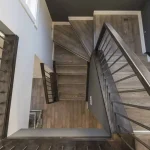Having a walk-in wardrobe is a dream for many homeowners. It’s not just about having more space; it’s about creating a sanctuary that reflects your style and meets your organizational needs. Whether you’re designing from scratch or upgrading an existing space, this guide will help you create a functional and beautiful walk-in wardrobe.
Start with a Clear Vision
Before diving into the design, it’s essential to have a clear vision of what you want. Think about how you will use the space and what elements are most important to you. Are you a fashion enthusiast with a vast collection of clothes and accessories? Or do you need a multifunctional space that includes a dressing area and storage for various items?
When I first started planning my walk-in wardrobe, I spent hours scrolling through Pinterest and home design magazines. I wanted a space that felt like a boutique, with everything easily accessible and beautifully displayed. My favorite feature turned out to be a small vanity area where I could get ready each morning, making the space both practical and luxurious.
Declutter and Organize
Marie Kondo, the organizing consultant, famously advises: “Declutter before designing. Focus on items that spark joy and create a functional and serene closet space.” This step is crucial. Before you start installing shelves and hanging rods, go through your belongings and declutter ruthlessly. Keep only what you truly love and need. This process will make organizing much easier and ensure that your new space feels calm and uncluttered.
Maximizing Space
Once you’ve decluttered, it’s time to think about how to maximize your space. Peter Walsh, a professional organizer, suggests: “Maximize your closet’s potential by utilizing every inch of space. Consider custom shelving and drawers to accommodate your belongings.”
Custom Shelving and Drawers
Custom shelving allows you to tailor the storage to your specific needs. Adjustable shelves can accommodate everything from shoes to handbags, while drawers provide a place for smaller items like jewelry and accessories. Don’t forget about vertical space—install shelves all the way up to the ceiling for items you don’t use every day.
Expert Insights
Joanna Gaines, an interior designer, emphasizes the importance of personalizing your space: “A walk-in closet should be a personal sanctuary. Design it to reflect your style and create a space that inspires you.” Think about incorporating elements like a comfy chair or a full-length mirror, as suggested by Nate Berkus, another interior designer. These touches can make your closet feel more like a luxurious retreat.
Lighting Matters
Good lighting is crucial in a walk-in wardrobe. Bobby Berk, an interior designer, says: “Lighting is crucial for a functional closet. Incorporate ample lighting to showcase your wardrobe and make getting dressed a pleasure.”
Types of Lighting
- Overhead Lighting: Ensure that your main light fixture is bright enough to illuminate the entire space. A chandelier or modern pendant light can add a touch of elegance.
- Task Lighting: Install task lighting around your mirror and vanity area for better visibility when getting ready.
- Accent Lighting: Use LED strips or spotlights to highlight specific areas, such as shelves or display cases. This not only enhances functionality but also adds a stylish touch.
When I upgraded my walk-in wardrobe, I added motion-sensor LED lights inside my shoe racks and drawers. It was a game-changer! Every time I opened a drawer or stepped into a dark corner, the lights would turn on automatically, making it so much easier to find what I needed.
Zoning Your Closet
Creating different zones within your closet can help keep everything organized. Hilary Farr, an interior designer, advises: “Create different zones within your closet for specific items like hanging clothes, folded items, and shoes to optimize organization.”
Hanging Clothes
Install double rods for hanging clothes—one higher for longer items like dresses and one lower for shorter items like shirts and pants. This doubles your hanging space without requiring more room.
Shelves and Drawers
Use shelves and drawers for folded items, accessories, and smaller belongings. Drawer dividers are excellent for keeping smaller items organized and easily accessible.
Shoe Storage
Consider dedicated shoe storage. Whether it’s cubbies, racks, or clear boxes, having a designated spot for each pair helps keep your shoes in good condition and easy to find.
Personal Touches
Adding personal touches can make your walk-in wardrobe feel special. Consider incorporating elements that reflect your personality and style.
Mirrors and Seating
A full-length mirror is essential for checking your outfits, but you can also add smaller decorative mirrors for a touch of glamour. A comfy chair or small bench provides a place to sit while putting on shoes or contemplating outfit choices.
Decor and Accessories
Incorporate decor items like artwork, plants, or decorative boxes. These elements add personality and warmth to your space. According to Nate Berkus, “Create a calming and inviting closet atmosphere by incorporating soft textures, mirrors, and perhaps even a small seating area.”
Staying Organized
Once your dream closet is set up, the key to maintaining it is regular upkeep. Set aside time each season to review your wardrobe, declutter, and reorganize as necessary. This habit ensures that your closet remains a functional and enjoyable space.
Resources and Studies
While there may not be specific studies dedicated solely to walk-in closets, these resources can provide valuable insights into home design, storage, and consumer behavior:
- National Association of Home Builders (NAHB): Studies on home design trends and consumer preferences can offer insights into closet design and storage solutions.
- Consumer Reports: Tests and reviews various home products, including storage solutions and furniture, which can inform closet design choices.
- The Association of Professional Organizers (APO): Offers resources and certifications for professional organizers, providing insights into effective storage and organization strategies.
- Home Improvement Magazines: Publications like Better Homes and Gardens, House Beautiful, and Architectural Digest often feature articles on closet design, organization, and storage solutions.
Conclusion
Creating your dream walk-in wardrobe is a rewarding project that combines organization with personal style. By decluttering, maximizing space, incorporating proper lighting, and adding personal touches, you can transform a simple closet into a luxurious and functional space. Remember to draw inspiration from experts like Joanna Gaines, Marie Kondo, and Peter Walsh, and make the space uniquely yours. Enjoy the process, and soon you’ll have a walk-in wardrobe that not only meets your needs but also brings joy to your daily routine.










